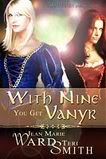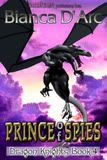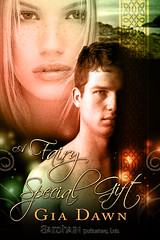From Sanbao to Sinbad: China’s Contribution to the Arabian Nights
If it walks like a duck and quacks like a duck and lays eggs like a duck, why do some people insist on telling you it’s a turkey?
No, this isn’t a political rant. I post very few of those, and never here. This has to do with my love-hate relationship with academia, specifically academic tunnel-vision. For every scholar like Adrienne Mayor, who actually reads what ancient and medieval writers wrote, there seem to be a thousand who are more interested in pedantry than possibility.
Case in point: Sinbad--he of the Seven Voyages, not the stand-up comedian.
Everybody knows the basic outline of Sinbad’s story. Starting from nothing, a young man becomes a wealthy and respected merchant after seven fabulous voyages take him to the ends of the earth--with a lot of stops for gold, girls and monsters along the way.
The accounts of the individual voyages show a variety of influences, from Greek mythology to Islamic theology garbled accounts of African and Asian fauna. But according to all “serious” scholars, the origin of the name Sinbad and why he had seven voyages (and not three or nine or fifteen like other Arabian Nights’ tales) is “lost in the mists of time”.
Of course, doesn’t stop scholars from trying to sell etymologies based on the old name of the Indus River, the Persian word for “region” and lots of specious Sanskrit. Not to mention lengthy articles on the mystical significance of the number seven. (Lesson to remember: whenever a scholar drags out the Sanskrit and numeric symbolism, run. He or she is trying to sell you the post-doctoral equivalent of land in the Florida swamps.)
This is where the duck quacks in. In 2005, “China’s Great Armada”, a National Geographic article by Frank Viviano, suggested the great Ming Dynasty admiral Zheng He might have been one of the prototypes for the character of Sinbad.
At first the idea seems absurd. Then the facts roll in. Despite the name (which was given to him by a grateful emperor after he reached adulthood), Zheng He was not Chinese. He was a Central Asian Muslim captured and enslaved as a child by the Chinese army, who rose on his own merits to become one of the principal advisors of Emperor Yongle.
Zheng He’s main claim to fame are the seven voyages he undertook in his emperor’s service, voyages which sent him--like Sinbad--to the fabulous lands of Sumatra, Java, India, Ceylon and East Africa. These voyages were designed to “show the flag” and obtain treasure through trade and diplomatic maneuvering, not conquest. The main object of the sixth voyage, for example, was to secure that rare and most fantastical animal, the ultimate harbinger of peace and prosperity in Chinese folklore of the time, a.k.a. the giraffe.
Zheng He also used the voyages to spread Chinese culture in all its stunning diversity. He commissioned statues of Buddha and the Taoist goddess of the sea. He served as a benefactor to Chinese Muslims, settling large communities in major ports of call along all his routes. His adventures so captivated so many people he remained a folk hero to Chinese communities throughout Asia even after he slipped from the rolls of most official histories. You couldn’t ask for a more fertile breeding ground for legends and tall tales. Think of all the other popular heroes you never read about in school--Robin Hood and King Arthur, for example.
But oddly enough--other than the fact he made seven voyages--the best, most telling connection to Sinbad is Zheng He’s original name. In Pinyin, the simplified Chinese phonetic alphabet, it is rendered "Ma Sanbao".
Roll “Sanbao” around your mouth a couple times. Next, imagine a transcontinental game of telephone, where everybody’s doing their best to repeat the same word but nobody has quite the same set of phonics.
The idea that over time names slip and slide into something which only faintly resembles the original is a well-known literary phenomenon. It’s one of the things that make it so difficult to parse out the historical bases of the Arthurian legends. For example, one of the few touchstones of Dark Age British history is the man Gildas and Bede call Ambrosius Aurelianus. He plays a major role in all the Arthurian legends, but unless you understand how the early Welsh mangled--er, transmitted Latin names, you might night recognize him. They call him “Emrys”.
Sanbao. Sinbad. Starts to look a lot better, doesn’t it?
But…but…Sinbad lives in Baghdad during the time of the great caliph Haroun al-Rashid! So does nearly everyone else in the Arabian Nights--including characters based on real people who lived in entirely different centuries. The Baghdad of Haroun al-Rashid was the Camelot of the medieval Arabian world. If it was fantasy, it had to be set there. No other place or time would do.
What about the roc and the Cyclops mentioned in Sinbad’s Third Voyage? I didn’t say Zheng He was the only model for Sinbad, just that he’s the most compelling and provides the best historical precedent for the Seven Voyage structure.
The great compendiums of folklore and legendary material--such as the Arabian Nights, the Brothers Grimm and the Matter of Britain--seldom derive from a single literary or oral source. They are the distillations of popular culture. The stories they encompass are constantly evolving and moving back and forth between literary and oral traditions.
Terri Windling’s "Folkroots" feature in the August 2007 Realms of Fantasy shows how this plays out in the story of Rapunzel. In the 19th century, the Brothers Grimm presented the story as a German folk tale. But in fact, the current form of the story derives from “Persinette”, an adult fairy tale written by Charlotte-Rose de la Force in late 17th century Paris.
According to Daniel Beaumont, the same forces were at work in the creation of the Arabian Nights. His introduction to Slave of Desire: Sex, Death, and Love in the 1001 Arabian Nights cites several examples of fables being transformed into fictions which are later quoted as “true events”, which happened to someone with a distant connection to the writer. (Urban legends, anyone? There really isn’t anything new anywhere under the sun.)
In addition, the story of Sinbad’s Seven Voyages doesn't appear to have been part of the earliest versions of the Arabian Nights. Most importantly for the Ma Sanbao/Sinbad connection, it doesn’t appear in the 14th century manuscript which leading Arabian Nights' scholars consider the definitive medieval version of the collection.
But then few of the best stories do. Certainly not the ones (like the story of Aladdin and his Wonderful Lamp) which display a distinct Chinese connection. Those stories don’t appear in Arabian Nights’ manuscripts until the 16th or 17th centuries--more than enough time for storytellers to embroider the original source material almost beyond recognition.
So why is it only the non-academic writers who admit the connection? Why does the theory appear to have no credibility among serious academics? Where is the scholar--or student or demented amateur with way too much time on their hands--to run all the tantalizing bits of evidence to the ground? Won’t somebody please take up the challenge of identifying all the ingredients in the glorious stew, how Zheng He’s treasure fleet--complete with concubines and Chinese marines--took a left turn at some medieval Arabic version of Albuquerque and wound up sailing with Odysseus?
I want to read it, dang it. I don’t want to have to go out there and write it myself.
Though the part about the Chinese marines and the concubines shows definite promise. Maybe on the island that’s also a whale…
Additional references (from Wikipedia):
Arabian Nights
Sinbad
Zheng He









3 comments:
Do you have any good books on Chinese mythology? I mean heroic tales, like the Greek myths.
There's a reason I need them - I have a couple I'm using, but I'd like to read more. Most of the 'fairy tales' I've read are more like moral stories, and those won't work for the purpose I need them for.
I don't have anything on Chinese mythology per se. I just start on Wikipedia, then work my way from there. For any research on Zheng He, however, I'll go looking for translations of his own commemorative stelae and the journals left by two of his subordinates.
However, while I was at ALA recently, I took advantage of the conference discount to stock up on some goodies:
Frances Carpenter: Tales of a Chinese Grandmother
Frances Carpenter: Tales of a Korean Grandmother
Kim So-Un and Jong Kyoung Sim: Korean Children's Favorite Stories
Yei Thodora Ozaki: Japanese Fairy Tales
Rosemarie Somaiah and Ranjan Somaiah: Indian Children's Favorite Stories
Harish Johari and Vatsala Sperling: How Parvati Won the Heart of Shiva
Vatsala Sperling: Ram the Demon Slayer
But I haven't had the chance to read any of them yet. Hope the list helps.
PS, you could also check out Barry Hughart's wonderful novels, including Bridge of Birds. The mythology cited will at least give you a few search terms.
Best wishes,
Post a Comment